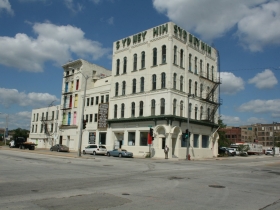Don’t Wreck Sidney Hih
The troubled history of municipal land clearance and why it’s a very bad idea to demolish Sidney Hih.
In 2005, the U.S. Supreme Court handed down a watershed decision in Kelo vs. New London. The ruling affirmed the city of New London’s use of eminent domain to take over private property owned by Susette Kelo, based on its dubious claim that her newly renovated house was blighting a seaside neighborhood of 19th century homes.
As a former mayor, I surprised some of my mayoral colleagues by submitting an Amicus brief defending Ms. Kelo’s property rights. From my experience and observation of state and city government I concluded long ago that clearance and consolidation of land by government for economic purposes rarely leads to good outcomes.
What made the attack on Kelo’s property rights seem so outrageous to me was the foolishness of the project New London and the state of Connecticut were supporting by condemning and removing her house and those of her neighbors. The city’s plan was to take ownership of the entire neighborhood, remove all the houses, consolidate the lots into one giant parcel and turn it over for one dollar a year to a developer who would build a retail mall, hotel, condos and parking lots on land adjacent to a new Pfizer Corporation pharmaceutical plant. Additionally, the city and state committed $80 million in direct subsides to the project.
Kelo and her neighbors lost on a 5-4 decision, in a case that gave eminent domain a bad name. New London’s plan, it turns out, failed completely. Nothing was built and after its tax abatement ran out, Pfizer shut its plant, which remains empty today.
A local example of site clearance is the empty block at 4th St. and Wisconsin Avenue facing the convention center next to the Grand Avenue. The block has been empty for almost 30 years. Before it was cleared by the city for eventual expansion of the Grand Avenue, the block included the 90-room Randolph Hotel, restaurants, a movie theater, a jeweler, a nightclub and office space and apartments above some of the stores. Most of the property owners on the block were current in their tax payments; since the city assumed ownership it has collected no property taxes.
After expansion of the Grand Avenue mall fell through the city plan for the 4th and Wisconsin land was changed to seek a hotel across the street from the new convention center. One argument for creating the new convention center was the expectation that it would induce new hotel construction. Building the new convention center included the demolition of the Belmont Hotel. This happened during my time as mayor. I resisted the demolition at first, but regrettably let it happen. The Grand Avenue project had earlier demolished two hotels, the Antlers where Frank Sinatra twice performed and the once elegant Plankinton. In all, four hotels in this area were removed to “foster development.”
The condemnation and demolition of the Milwaukee Road and Chicago & Northwestern railroad stations, the Layton Art Gallery and Milwaukee Envelope’s factory next to MATC are all examples of counter productive downtown demolition, yet Milwaukee also has had some happy outcomes. The Pabst Theater was saved. The Third Ward was spared clearance and is a vibrant, valuable sector of downtown. The Beerline “B” development along the Milwaukee River was built on a 28-acre former rail yard. The city cleaned, coded and divided the site into six sections. Developers competed for the parcels in six design competitions and those that won then paid a fixed price for the land. The coding was calibrated to the scale of the Brewers Hill and Brady Street neighborhoods. The results are spectacular, with hundreds of millions of dollars added to the tax base. More recently, the Pabst Brewery site has been thoughtfully redeveloped and in-fill projects have been carefully inserted into many of Milwaukee’s neighborhoods such as Walker’s Point and North and Prospect.
Now Sidney Hih is under attack again. The City and County offer to site Kohl’s corporate headquarters in the Park East corridor was rejected. Kohl’s, unlike Target, has always been uncomfortable with urban locations for its stores, and was an unlikely recruit to downtown. You really need a corporate leader to want to be downtown — like Bob Mariano who moved Roundys to East Wisconsin Avenue from Waukesha County or Jeffrey Joerres of Manpower. Disappointment with Kohl’s rejection may have motivated city and county officials to think Sidney Hih’s run-down condition prevented the relocation. I doubt that Sidney Hih was a factor at all, but a corporate headquarters that rejected the Park East site even though a huge subsidy was offered may not have been a good long-term play.
In New London, Connecticut, the city thought it knew best and created a mess. Now Milwaukee has a decision to make. Tear down buildings that have been a part of the city’s fabric for 130 years or let rehabber John Raettig or someone like him try to purchase and restore the buildings. Raettig prides himself on not seeking subsidies for his projects. He says he can put the Sidney Hi back on the tax rolls. Saving a remnant of Milwaukee’s Downtown North area could help its revitalization just as preservation helped the Third Ward. The corridor is coded for complex mixed-use buildings on blocks and streets. It’s really not meant to be a suburban-style business park. It’s meant to be part of the city fabric. The city should get back to its own plan; Sidney Hih fits that plan just fine.
Norquist
-
Why Milwaukee Needs a Streetcar
 Aug 24th, 2018 by John Norquist
Aug 24th, 2018 by John Norquist
-
Trump Tariffs Will Hurt State Workers
 Mar 2nd, 2018 by John Norquist
Mar 2nd, 2018 by John Norquist
-
Trump Tariffs Will Hurt State Workers
 Feb 2nd, 2017 by John Norquist
Feb 2nd, 2017 by John Norquist






















Well, I’d take it either way.
I love the Sydny Hih building, but let’s be honest, it’s not in great condition. I’d let it go it it means something quality would be built there. It’s a cool building, but it’s not *that* big of a loss…
Nostalgia for the Norquist doctrine on development is palpable amongst most of us who engage in urbanist dialogue these days- at least in my circles. I hope our current leaders read this with the deference it deserves. I thank Mayor Norquist for weighing in with his perspective. Many in my cohort were too young to appreciate “new urbanism” polices at the time the Norquist administration was changing the trajectory of Milwaukee. Yet, ironically, most of us are now both beneficiaries of and the new evangelists for the movement. I hope we can reconcile the foresight of our forefathers with the well- intended efforts of our current leaders. We, your people, want you to recognize the wisdom of the past together with the voices of the new generation it has inspired as you forge our future. Let’s align in passionate pursuit of the best possible Milwaukee. Our efforts need not be mutually exclusive.
Well said Juli, and well said Mayor Norquist.
I’ll never understand City leaders that fail to grasp the core of what makes Milwaukee so attractive to visitors and residents alike. I’ve heard time and time again people remark about the historic architecture of Milwaukee and the impact it has on those that have never stepped foot in this city before. It’s memorable, it’s unique, and it has a soul. Traveling to cities around the country, it’s easy to see why the bones of Milwaukee are so shocking to outsiders. Many, if not most of our cities have been stripped of their history in the interest of “progress.” More often than not progress equates to surface parking lots or homogenous architecture.
Milwaukee has done better than most in this regard, despite the terrible decisions cited in the post above. And now we don’t have the excuse of saying we didn’t understand what we were doing at the time. Thoughtful people understand all too well that our best neighborhoods are historic at their core. It’s the scale, pace of buildings, materials, and human details that all work together to create street life and vibrancy. The Sidney Hih has all of that, and it’s completely savable, despite what some would like you to think.
There’s no new development in the wings. Nothing. So how about letting somebody that’s done this before take a swing at rehabbing this interesting set of buildings. Not because is has a romantic history, but because it contains the seeds for creating a vibrant new street, and maybe a vibrant new neighborhood.
John, I like your vision and description of the possibilities. Well seen, well spoken:
“Saving a remnant of Milwaukee’s Downtown North area could help its revitalization just as preservation helped the Third Ward. The corridor is coded for complex mixed-use buildings on blocks and streets. It’s really not meant to be a suburban-style business park. It’s meant to be part of the city fabric. The city should get back to its own plan; Sidney Hih fits that plan just fine.”
As a business owner in the Third Ward I have nothing but praise for saving the old, which continues to give the city texture and interest. The big testament to the Third Ward, however, is not the buildings but the people who come and approve daily, crowds of people daily, and art-hungry and digs-curious crowds on weekends. We need more preservation. Corporations won’t save us from our mistakes but tempt us only to become like something we are not.
The New London story is chilling in the money it wasted and lives it destroyed. I love Milwaukee’s historic buildings; sure they’re beautiful and have interesting histories, but more importantly they have the weight of Place. They strengthen neighborhoods because they provide a link to the past, generational continuity and sincere nostalgia. How sad would it be if our deepest connection with the past was a strip mall built in the 60s? That’s reality in countless suburbs.
Mr. Norquist, won’t you please, please run for governor in 2014? Please!
I’m cursing the Park East corridor–may it remain a black hole of tax revenue that continues to plague the city thanks to these underhanded decisions.
Those of us familiar with Sidney Hi are still mourning the loss of “Betty’s Bead Bank”!
I was cheered to read this article on the folly of clearing and consolidating lots for development. A small complex of restored buildings will always have more interest to me in an urban context than an ill-concepted idea of “cleaning up for progress.” A totally redevloped swatch badly needs some historic contrast to help repair the damage done by urban renewal and expressways that destroyed so much of the city decades ago.
Where would Brewers Hill be if only buildings in good condition were saved? There was hardly such a thing there, but it didn’t stop those with a vision of how things could be even if these same people were thought crazy. Give this plan to restore Sydney Hih a fair hearing and stop saying such an outcome is stopping progress!
It is great to have John Norquist weigh in. It puzzles me that the city is in such a hurry to tear down Sydney Hih. It may indeed be beyond saving but why not give people like Raettig a chance to try
Living in MKE for about 8 years now, I admit never noticing the Sidney Hih building. I sounds like the building is in pretty dire condition now, and I’m comfortable repurposing the land. What I’m not comfortable with however, is the consolidation of the land into one giant parcel. It’s well known to us city dwellers that mixed-use land promotes thriving neighborhood economy.
It would be great if we could attract a developer like the one who created Glendale’s Bayshore Town Center and Columbus’ Easton Town Center. While not the most ideal, they’ve taken those large chunks of land and built something that encourages outdoor foot traffic that we can all agreed upon.